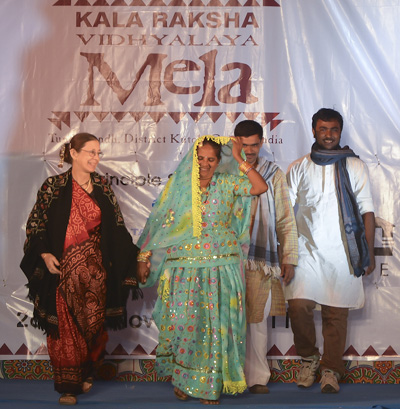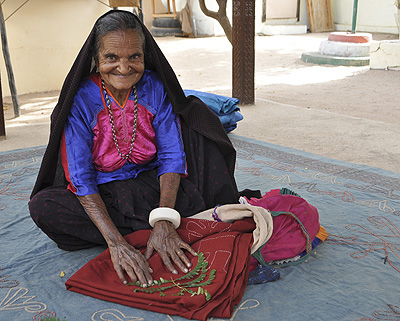|


Judy Frater helped establish the Kala Raksha Vidyalaya to nurture, support & horne the skills of traditional craftspersons in India. An interview by SUPRIYA D.G.
" I was just thinking that what we intend is the ultimate self help project, in which artisans give the most intimate of their household possessions, designed and created by them and for themselves, to help each other in difficult times" goes Judy Frater's poignant words as she summarizes her thoughts for a brief interview with NRI Pulse on the eve of an unique auction, on March 30th at ARTISAN's at Kala Ghoda in Mumbai.
Judy Frater first came to India in 1970 as an exchange student and subsequently to study the then dying art form called Rabari. She set up a non profit organization called Kala Raksha in 1993 to rejeuvinate traditional art forms. In what constitutes a self sustaining model, art as it is known to the artisans is not compromised. For the artisans who work from home, material is supplied from the centre at Kala Raksha and the workers are paid per item. Besides the store at Kala Raksha, exhibitions are held across the country in major metros and there are plans to hold international ones as well.
Judy Frater helped establish the Kala Raksha Vidyalaya to nurture, support & horne the skills of traditional craftspersons in 2005. Following the devastating earthquake in 2001 in Bhuj, most of the artisans lost what was their sole means of livelihood. It was this tragedy that provided an impetus to resurrect what was in the danger of being lost: a legacy of tradition and a sense of pride in an achievement.

Over to the interview.
Is the quilt exhibition/auction At Kala Ghoda the first of its kind for Kala Raksha?
The exhibition is of new products from Kala Raksha for summer. The overall theme is comfort, and the exhibition highlights are cool whites, products inspired by the traditional objects in the Kala Raksha Museum, and narratives of artisans' visions of paradise.
What is the first of its kind is an auction of traditional home quilts of the artisan members of Kala Raksha. Kala Raksha does not generally encourage artisans to sell their own traditional work. However, we asked them to give their everyday quilts- which rarely are seen by the public or collectors- as a gesture of personal assistance for our new Medicine from Poison fund to assist Kala Raksha members with large, unexpected medical expenses. Thirty-one quilts will be auctioned.
What did you hope to achieve from this interactive forum?
We exhibit and sell in major metros every year. It is a primary way in which we earn funds to run our organization which is one of the few NGOs which is self sustaining. But Radhi's ARTISANS' gallery is an especially appropriate and effective venue.
How has Art helped the women of Kutch?
Kala Raksha considers traditional art the core resource that artisans hold, which can potentially be a source of income at a more desirable level than that of manual labour. Kala Raksha engages women in the designing and pricing, as well as production of work. Thus, they are full participants in the income generation work that we do. Because each work is created as a unique piece, we hope the work will be valued as art. Since 2005 we have furthered our philosophy by establishing a design school for artisans, Kala Raksha Vidhyalaya. Graduates have increased their capacity as artisan designers, and each year twelve women are engaged to create samples for the Kala Raksha collections. In 2010, Kala Raksha launched the trademarked concept Artisan Design to highlight and value work that is designed and created by the artisan.
Does commercialization affect the creative expression of the artisans?
Yes, in that most commercial work is designed by a professional person, printed on fabric and filled in with embroidery by an artisan. In such work there is little opportunity for creative expression.
How do you encourage traditional artisans without enslaving them to a destiny? Or preserving a tradition with the threat of none to carry on a legacy?
Through our Kala Raksha design workshops and now the Vidhyalaya, we encourage artisans to know and appreciate their unique traditions, and then to innovate within them. Traditions always evolved, but always through the innovations and directions of the artisans themselves. We encourage artisans to continue to own and direct their traditions.
Do you see an opportunity for a worldwide exhibition & distribution?
I do think there is an opportunity to exhibit and distribute artisan designed work world wide! We hope to hold several workshops and trunk shows in the USA this July and August. It is still to be arranged.
Click
here to send Gifts to India
|

